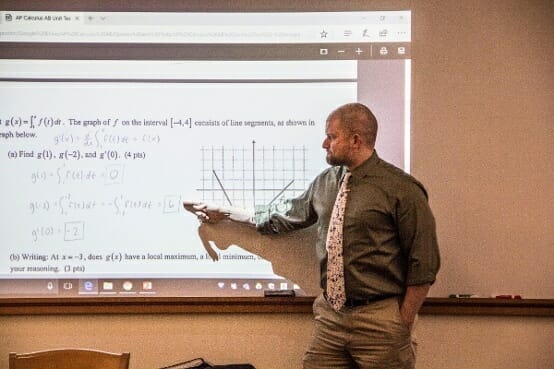A 101 on (PD)^2 at MICDS
 Math and Psychology Teacher Aaron Proctor is constantly thinking about thinking — and not just about his own thinking, but his students’ as well. In fact, last year, his Professional Development (known at MICDS as (PD) ^2—pronounced PD squared) goal was to improve his use of formative assessments. Formative assessments are activities or lessons that help a teacher understand how effective their teaching methods are, or where in the unit there might be gaps in learning. One of Proctor’s most effective assessments last year was a lesson called “My Favorite No.”
Math and Psychology Teacher Aaron Proctor is constantly thinking about thinking — and not just about his own thinking, but his students’ as well. In fact, last year, his Professional Development (known at MICDS as (PD) ^2—pronounced PD squared) goal was to improve his use of formative assessments. Formative assessments are activities or lessons that help a teacher understand how effective their teaching methods are, or where in the unit there might be gaps in learning. One of Proctor’s most effective assessments last year was a lesson called “My Favorite No.”
“I give the students a warm-up problem, exercise or writing prompt,” Proctor said. “They turn them in without their names on them, and I look for the answers that are incorrect. Then I choose my favorite wrong answer — the one that offers the most potential for classroom learning. We project it in front of the class and talk about why it’s not right. It allows me to track what my students might not be understanding, and it gives the students a chance to celebrate and learn from their mistakes. It also enhances the way they think about the reasoning process — a concept called metacognition.”
Each month for the entire academic year, Proctor chose a different formative assessment and applied it in the classroom. Another successful assessment involved using the walls of the classroom to chart individual personal experiences and how they relate directly to the unit’s learning modules. No matter the assessment, Proctor constantly received feedback from his students about how his teaching impacted their own understanding of the content.
What is (PD)^2?
Forming a singular teaching goal and implementing that goal during a set amount of time is the professional development norm at MICDS — a process created by department chairs, deans and faculty and officially called (PD) ^2, professional development powered by Danielson.
“Two years ago, we went through the design thinking process to fully address our own community — to create a program that fills our specific needs rather than a model that’s been used at another school. It is valuable because our investment in it is greater,” said JK-12 English Department Chair Lynn Mittler, who helped oversee the shift in the School’s approach to professional growth.
Since then, (PD) ^2 has replaced the age-old idea of goal-setting at the beginning of the year and self-reflection at the end of the year — a process that many schools still implement but one that often doesn’t engender actionable or quantifiable growth in teachers. Instead, (PD) ^2 at MICDS is ongoing and organic. It transcends the academic year and joins teachers together under a common desire to improve.
“The themes surrounding (PD) ^2 at MICDS are: authenticity, ownership and transparency. At a place like MICDS where everyone has an extremely high growth mindset, this system works extremely well, mostly because teachers take ownership of the process,” said Proctor.
Forming Accountabilibuddies (Say What?)
At MICDS, collaboration and feedback are important parts of the learning process for students — and teachers too. When teachers create goals to improve their effectiveness, they work closely with one other teacher to track their progress, and vice versa. At MICDS, we call this relationship an “accountabilibuddy.”
“An ‘accountabilibuddy’ is like a workout buddy who holds you accountable to doing your part,” said Mittler. “Teachers meet with their accountabilibuddies monthly to debrief where they are with their goal. Subsequently, they document those conversations and reflections.”
The relationships teachers form help them become more transparent about their desire to improve and the actionable steps they are taking to do so. Mittler adds, “Talking through your work with a colleague helps crystallize your own thinking and gives your colleague great ideas as well.”
Getting Down with the Danielson Framework
Another component of (PD) ^2 is the Danielson Framework — a prominent teaching and learning framework created by Charlotte Danielson that guides conversations around successful teaching and learning.
“Danielson gives us the common vocabulary to talk about good teaching,” said Proctor. “Whatever goal a teacher is working on — it should be tied somehow to Danielson.”
The Danielson Framework is made up of four domains: planning and preparation, the classroom environment, professional responsibilities and instruction. So, for a goal such as Proctor’s desire to improve formative assessment, the primary components of that goal would fall within two domains: planning and preparation and instruction. However, the secondary components might fall into the other two: the classroom environment and professional responsibilities.
For another faculty member, her goal might be to improve her rapport with students, one that would fit squarely into the classroom environment domain. During her time working on that goal, she might video-record her interactions with students and play them back for feedback. Or, she might observe a classroom where a faculty member has been known to have positive rapport. Conversely, she might have another teacher observe her. In addition, she might continually survey her students. Once that teacher has documented her growth and can conclude goal-achievement, she chooses another goal to work on. All the while, she continues to sharpen those teaching tools she now has in her toolbox.
“The core underlying philosophy of (PD) ^2 is that, rather than forcing our teachers to fit into a system that’s artificial, let’s make the system mold around what we are already trying to do as educators. It puts an innovative spin on professional growth,” said Proctor.